Related Research Articles

Edgar Rice Burroughs was an American writer, best known for his prolific output in the adventure, science fiction, and fantasy genres. Best known for creating the characters Tarzan and John Carter, he also wrote the Pellucidar series, the Amtor series, and the Caspak trilogy.

Cheeta is a chimpanzee character that appeared in numerous Hollywood Tarzan films of the 1930s–1960s, as well as the 1966–1968 television series, as the ape sidekick of the title character, Tarzan. Cheeta has usually been characterized as male, but sometimes as female, and has been portrayed by chimpanzees of both sexes.
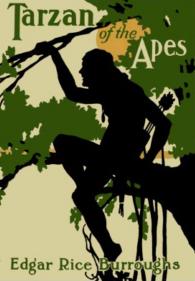
Tarzan of the Apes is a 1912 novel by American writer Edgar Rice Burroughs, and the first in the Tarzan series. The story was first printed in the pulp magazine The All-Story in October 1912 before being released as a novel in June 1914.
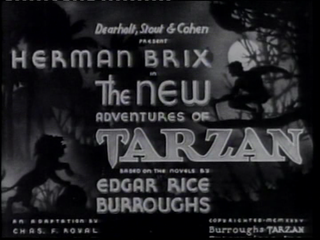
The New Adventures of Tarzan is a 1935 American film serial in 12 chapters starring Herman Brix. The serial presents a more authentic version of the character than most other film adaptations, with Tarzan as the cultured and well-educated gentleman in the original Edgar Rice Burroughs novels. It was filmed during the same period as the Johnny Weissmuller/Metro-Goldwyn-Mayer Tarzan films. Film exhibitors had the choice of booking the serial in 12 episodes, the feature film, or the feature film followed by 11 episodes of the serial.
Mangani is the name of a fictional species of great apes in the Tarzan novels of Edgar Rice Burroughs, and of the invented language used by these apes. In the invented language, Mangani is the apes' word for their own kind, although the term is also applied to humans. The Mangani are represented as the apes who foster and raise Tarzan.
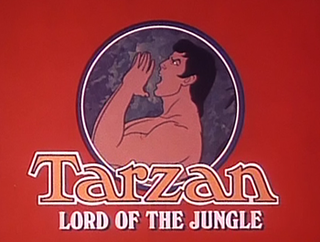
Tarzan, Lord of the Jungle is an American animated series created by the Filmation studio for Saturday mornings on CBS, starting in 1976. This was the first animated series about the jungle hero. There are 36 episodes produced over four seasons.

Jane Porter is a fictional character in Edgar Rice Burroughs's series of Tarzan novels and in adaptations of the saga to other media, particularly film. Jane, an American from Baltimore, Maryland, is the daughter of professor Archimedes Q. Porter. She becomes the love interest, later the wife of Tarzan and subsequently the mother of their son, Korak. She develops over the course of the series from a conventional damsel in distress, who must be rescued from various perils, to an educated, competent and capable adventuress in her own right, fully capable of defending herself and surviving on her own in the jungles of Africa.
Tarzan is a character created by writer Edgar Rice Burroughs.

Tarzan the Untamed is a book by American writer Edgar Rice Burroughs, the seventh in his series of twenty-four books about the title character Tarzan. It was originally published as two separate stories serialized in different pulp magazines; "Tarzan the Untamed" in Redbook from March to August, 1919, and "Tarzan and the Valley of Luna" in All-Story Weekly from March to April 1920. The two stories were combined under the title of the first in the first book edition, published in 1920 by A. C. McClurg. In order of writing, the book follows Jungle Tales of Tarzan, a collection of short stories about the ape-man's youth. Chronologically, it follows Tarzan and the Jewels of Opar.
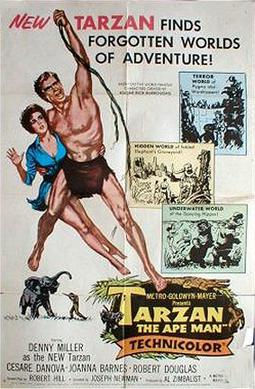
Tarzan, the Ape Man is a 1959 American action adventure film released by Metro-Goldwyn-Mayer starring Denny Miller as Tarzan, Joanna Barnes as Jane, Cesare Danova, and Robert Douglas. The film is loosely based on Edgar Rice Burroughs' novel Tarzan of the Apes, and is a remake of the classic 1932 film of the same name. The film was directed by Joseph M. Newman, and the score was composed by jazz musician Shorty Rogers. MGM would release another remake of the film in 1981.

Jungle Tales of Tarzan is a collection of twelve loosely connected short stories by American writer Edgar Rice Burroughs, comprising the sixth book in order of publication in his series of twenty-four books about the title character Tarzan. Chronologically the events recounted in it occur within Chapter 11 of the first Tarzan novel, Tarzan of the Apes, between Tarzan's avenging of his ape foster mother's death and his becoming leader of his ape tribe. The stories ran monthly in Blue Book magazine, September 1916 through August 1917 before book publication in 1919.

Tarzan the Tiger (1929) is a Universal movie serial based on the novel Tarzan and the Jewels of Opar by Edgar Rice Burroughs. It stars Frank Merrill as Tarzan, Natalie Kingston as Jane, and Al Ferguson. It was directed by Henry MacRae.
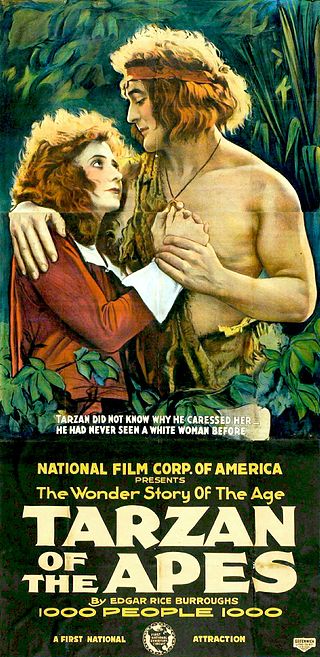
Tarzan, a fictional character created by Edgar Rice Burroughs, first appeared in the 1912 novel Tarzan of the Apes, and then in twenty-four sequels by Burroughs and numerous more by other authors. The character proved immensely popular and quickly made the jump to other media, first and most notably to comics and film.

Tarzan, a fictional character created by Edgar Rice Burroughs, first appeared in the 1912 novel Tarzan of the Apes, and then in 23 sequels. The character proved immensely popular and quickly made the jump to other media, including comics.

Tarzan and the Jungle Boy is a 1968 adventure film starring Mike Henry in his third and final appearance as Tarzan. Rafer Johnson and Aliza Gur co-star. The film was produced by Sy Weintraub and Robert Day, written by Stephen Lord and directed by Robert Gordon. Released on May 1, 1968, it is the twenty-eighth and final film in the Tarzan film series that began with 1932's Tarzan the Ape Man, and was followed by a self-titled remake film in 1981.

Tarzan and the Lost Safari is a 1957 action adventure film featuring Edgar Rice Burroughs' famous jungle hero Tarzan and starring Gordon Scott, Robert Beatty, Yolande Donlan and Betta St. John. Directed by H. Bruce Humberstone, it was the first Tarzan film released in color, Eastman Color. The nineteenth film of the Tarzan film series that began with 1932's Tarzan the Ape Man and the first produced by MGM since 1942, it was filmed in Nairobi, British East Africa. The character of Jane does not appear in this motion picture. Released April 12, 1957, it was followed by Tarzan and the Trappers in 1958.

Tarzan the Fearless is a 12 chapter American Pre-Code film serial starring Buster Crabbe in his only appearance as Tarzan. It was also released as a 61-minute feature film which consisted of the first four chapters edited together, and which was intended to be followed on a weekly basis by the last eight chapters in individual episode format, but which was often exhibited instead as a stand-alone feature film. Actress Jacqueline Wells co-starred; she later changed her name to Julie Bishop. The serial was produced by Sol Lesser, written by Basil Dickey, George Plympton and Walter Anthony, and directed by Robert F. Hill. The film was released in both formats on August 11, 1933.

Tarzan is a fictional character, a feral child raised in the African jungle by the Mangani great apes; he later experiences civilization, only to reject it and return to the wild as a heroic adventurer.
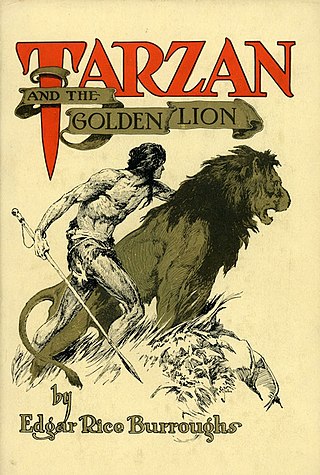
Jad-bal-ja, the Golden Lion is a fictional character in Edgar Rice Burroughs's Tarzan novels, and in adaptations of the saga to other media, particularly comics.

Tarzan is a series of 24 adventure novels written by Edgar Rice Burroughs (1875–1950) and published between 1912 and 1966, followed by several novels either co-written by Burroughs, or officially authorized by his estate. There are also two works written by Burroughs especially for children that are not considered part of the main series.
References
- ↑ Terrace, Vincent (1999). Radio Programs, 1924-1984: A Catalog of More Than 1800 Shows. McFarland & Company, Inc. ISBN 978-0-7864-4513-4. P. 326.
- 1 2 3 4 5 6 7 Cox, Jim (2002). Radio Crime Fighters: More Than 300 Programs from the Golden Age. McFarland. pp. 248–250. ISBN 9781476612270 . Retrieved 9 September 2016.
- 1 2 3 ""Tarzan" Series Tests Produce 93,000 Letters In First Eight Weeks" (PDF). Broadcasting. December 15, 1932. p. 13. Retrieved 9 September 2016.
- ↑ "Transcriptions" (PDF). Broadcasting. December 1, 1932. p. 24. Retrieved September 9, 2016.
- ↑ Sies, Luther F. (2014). Encyclopedia of American Radio, 1920-1960, 2nd Edition. McFarland & Company, Inc. ISBN 978-0-7864-5149-4. Pp. 680-681.
- ↑ Stebbins, Barton A. (January 15, 1933). ""Tarzan": A Modern Radio Success Story" (PDF). Broadcasting. p. 7. Retrieved 9 September 2016.
- ↑ "Broadcasters Accept Challenge of 1933". Broadcasting. January 1, 1933. pp. 5–9. Retrieved 9 September 2016.
- ↑ Briggs, Andy (2013). The Savage Lands. Open Road Media. ISBN 9781480400108 . Retrieved 10 September 2016.
- 1 2 "Merchandising Notes" (PDF). Broadcasting. February 1, 1936. p. 24. Retrieved 9 September 2016.